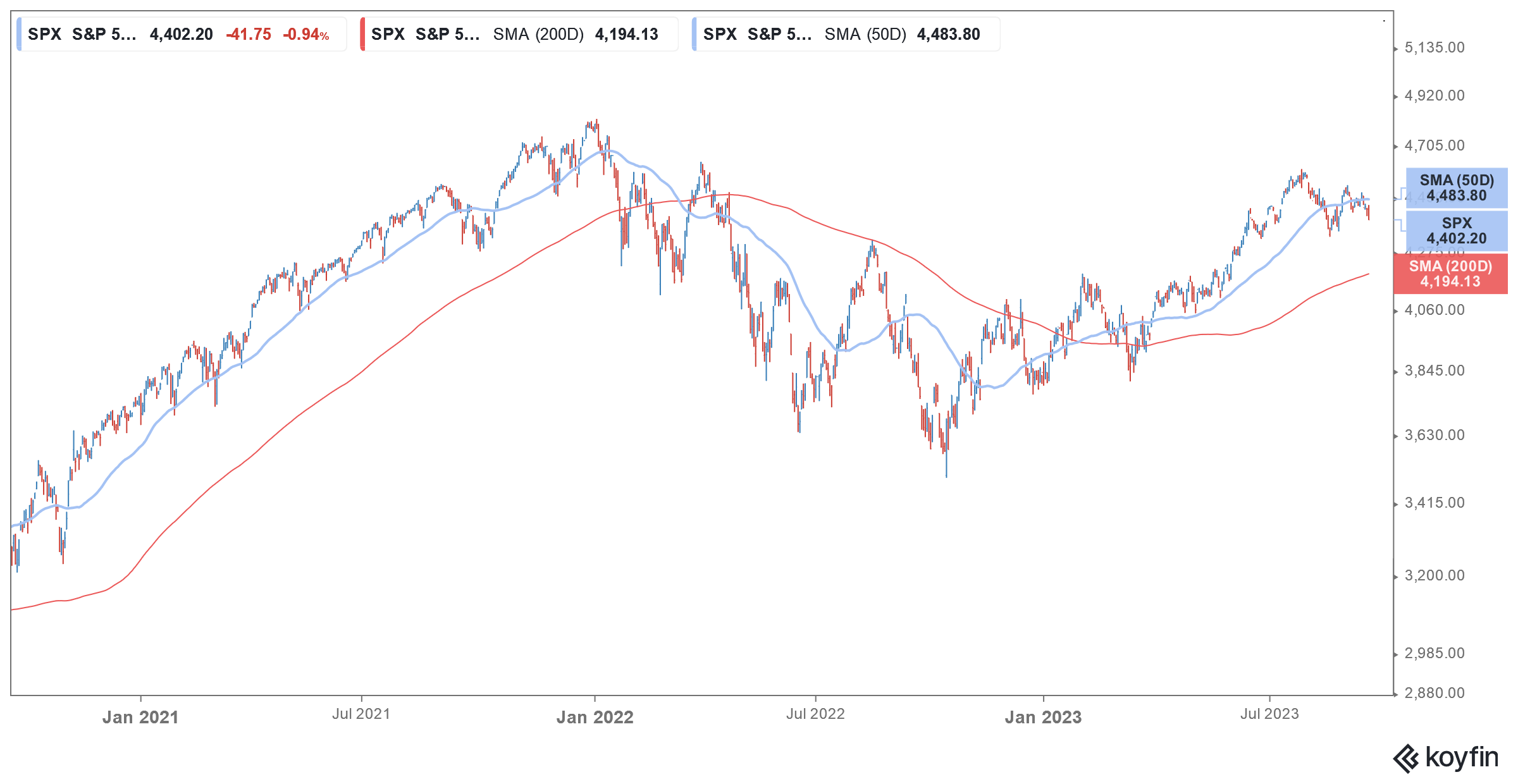Fed Holds Rates but Signals a Slow Path Towards Rate Cuts
Please note that we are not authorised to provide any investment advice. The content on this page is for information purposes only.
After its two-day meeting concluded yesterday, the US Federal Reserve kept its policy rates unchanged in the range of 5.25%-5.5%. While the rate decision was in line with what markets expected, Fed chair Powell sounded more hawkish than what markets were expecting and the dot plot called for only a 50 basis point rate hike in 2024.
The Fed’s September statement was largely similar to the previous meeting in July. However, the September statement says that US economic activity is expanding at a “solid” pace while the previous release termed it as “modest.” It also raised its 2023 GDP growth forecast for the US economy to 2.1% which looks quite healthy given the macroeconomic situation.
Also, after the recent economic data showed some softening of labor market conditions, the Fed changed job growth remaining “robust” to saying it “slowed” in recent months “but remain strong.”
Fed Signals One More Hike
Fed’s dot plot shows one more rate hike in 2023 which if comes true would be the 12th rate hike in this cycle. The US central bank raised rates seven times in 2022 which included four consecutive rate hikes of 75 basis points. Since March 2022 it has raised rates at all but two meetings but has graduated to 25 basis points this year.
Rates are expected to stay higher for longer
The Fed’s dot plot showed only 2 rate hikes of 25 basis points in 2024 and at his press conference Powell said, “Broadly, stronger activity means we have to do more with rates, and that’s what that meeting is telling you.”
He added, “We want to see convincing evidence really that we have reached the appropriate level, and we’re seeing progress and we welcome that. But, you know, we need to see more progress before we’ll be willing to reach that conclusion.” Powell emphasized, that “the process of getting inflation sustainably down to 2% has a long way to go.”
Powell says the Fed is committed to restoring price stability
During his press conference, Powell reiterated that the Fed is committed to restoring price stability and bringing inflation to its targeted 2%.
Powell said, “The worst thing we can do is to fail to restore price stability, because the record is clear on that.” He added, “If you don’t restore price stability, inflation comes back and … you can have a long period where the economy is just very uncertain, and it’ll affect growth. It … can be a miserable period to have inflation come constantly coming back and the Fed coming in and having to tighten again and again.”
US inflation has been sticky
Notably, US inflation peaked at 9.1% in June 2022. While the annualized inflation has since fallen and rose 3.7% in August, the pace of reduction has slowed down and on a monthly basis, the CPI rose by 0.6% in August which was the biggest pace of rise in 2023. Also, as we start moving to a low base, US annualized inflation might remain elevated in the coming months.
Powell on “soft landing”
Previously, Powell has talked about a “soft landing” as a likely economic outcome of the Fed’s rate hikes. At the press conference though while responding to a question on whether soft landing is a “baseline expectation” Powell said, “No, no, I would not do that. I’ve always thought that the soft landing was a plausible outcome, that there was a path to a soft landing.”
He stressed that “It’s also possible that the path has narrowed and widened.” He added, “Ultimately this may be decided by factors outside of our control at the end of the day, but I do think it’s possible.”
According to Powell, “I also think this is why we are in a position to move carefully, again. We will restore price stability, and we know we have to do that and we know that the public depends on us doing that.”
Higher oil prices might fuel inflation
The recent rise in oil prices might also add to inflation and DoubleLine Capital CEO Jeffrey Gundlach believes that the Fed might raise rates again amid the rise in oil prices. He said, “I think the probability of rate hikes is higher than what I thought before this oil spike happened.” Gundlach added, “The oil spike is really going to be problematic.”
According to Gundlach, “We already know that the base effects, the roll-off of the CPI, is going to lead to very likely inflation going back up to … maybe even going to a four handle on headline CPI before it comes down with that shelter component effect,” Gundlach said, referring to core inflation above 4% rather than 3%. “So I think the chance of a rate hike is higher because these oil prices are going to be a real problem.”
US stocks fell after Fed meeting
Meanwhile, US stocks fell after the Fed meeting yesterday as Powell’s commentary spooked investors. While US stocks were strong in the first half and the Nasdaq Composite had its best start to the year in four decades, we have seen some selling pressure amid concerns over the Fed’s policy.
However, on multiple occasions, Powell has dashed hopes of steep rate cuts and reiterated its stance at the September meeting. With US inflation still running way above the Fed’s target and rising oil prices stoking inflation fears, the Fed’s job has gotten even tougher.
Meanwhile, the market is divided on whether the Fed would raise rates again in 2023 as the dot plot shows. Gina Bolvin, president of Bolvin Wealth Management Group said, “The economy is growing stronger than the Fed thought and no one- not even Powell- knows what they will do in the 4th quarter.”
She added, “For sure the Fed is back to a neutral stance on balancing inflation vs employment. We are far from the recession many have predicted. We are closer to a soft landing.”






